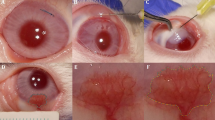Abstract
Objective
To report the efficacy of subconjunctival bevacizumab injection in patients with corneal neovascularization (NV).
Methods
This retrospective interventional case study included two eyes of two patients with corneal NV due to aqueous-deficient dry eye with filamentary keratitis in the first case, and corneal graft failure in the second case. Patients received a subconjunctival injection of 2.5 mg (0.1 ml) bevacizumab. Morphologic changes were investigated by slit-lamp biomicroscopy and corneal photography.
Results
Corneal NV was dramatically regressed a week after injection in the first case. In the second case, minor vessels were regressed while the major one did not. No infection or inflammation was observed. No relapse was seen within the follow-up of two to three months.
Conclusion
Subconjunctival injection of bevacizumab may offer an additional strategy for the treatment of corneal NV.


Similar content being viewed by others
References
Abraham-Marin ML, Cortes-Luna CF, Alvarez-Rivera G, Hernandez-Rojas M, Quiroz-Mercado H, Morales-Canton V (2006) Intravitreal bevacizumab therapy for neovascular age-related macular degeneration: a pilot study. Graefe’s Arch Clin Exp Ophthalmol [Epub ahead of print]
Amano S, Rohan R, Kuroki M, Tolentino M, Adamis AP (1998) Requirement for vascular endothelial growth factor in wound- and inflammation-related corneal neovascularization. Invest Ophthalmol Vis Sci 39:18–22
Bashshur ZF, Bazarbachi A, Schakal A, Haddad ZA, El Haibi CP, Noureddin BN (2006) Intravitreal bevacizumab for the management of choroidal neovascularization in age-related macular degeneration. Am J Ophthalmol 142:1–9
Chang JH, Gabison EE, Kato T, Azar DT (2001) Corneal neovascularization. Curr Opin Ophthalmol 12:242–249
Iliev ME, Domig D, Wolf-Schnurrbursch U, Wolf S, Sarra GM (2006) Intravitreal bevacizumab (Avastin) in the treatment of neovascular glaucoma. Am J Ophthalmol 142:1054–1056
Philipp W, Speicher L, Humpel C (2000) Expression of vascular endothelial growth factor and its receptors in inflamed and vascularized human corneas. Invest Ophthalmol Vis Sci 41:2514–2522
Wang Y, Fei D, Vanderlaan M, Song A (2004) Biological activity of bevacizumab, a humanized anti-VEGF antibody in vitro. Angiogenesis 7:335–345
Acknowledgements
The authors have no financial interest in any of the products mentioned in the manuscript and no financial support or sponsorship.
Author information
Authors and Affiliations
Corresponding author
Rights and permissions
About this article
Cite this article
Erdurmus, M., Totan, Y. Subconjunctival bevacizumab for corneal neovascularization. Graefes Arch Clin Exp Ophthalmol 245, 1577–1579 (2007). https://doi.org/10.1007/s00417-007-0587-4
Received:
Revised:
Accepted:
Published:
Issue Date:
DOI: https://doi.org/10.1007/s00417-007-0587-4




